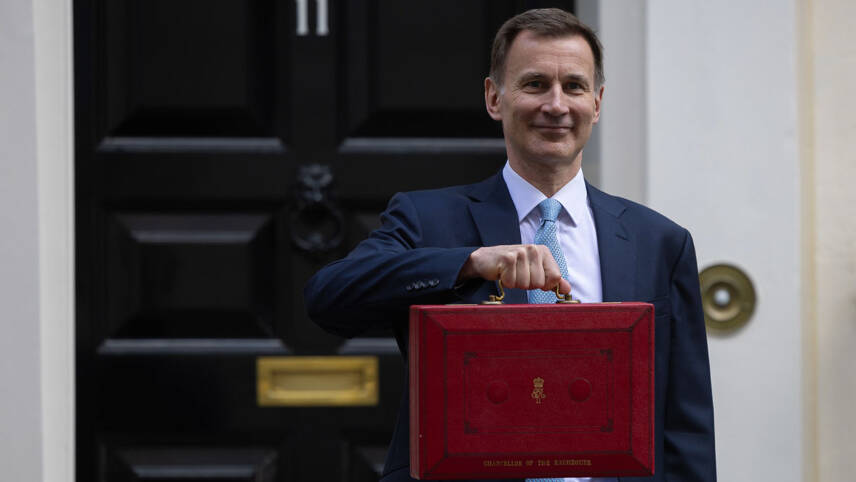This premium content is exclusive to edie Members.
To find out more about edie Membership, please click below.
If you are an existing member, login here

Image: HM Treasury. CC BY-NC-ND 2.0 DEED. https://www.flickr.com/photos/hmtreasury/53571370544/
There was little hope for Hunt to produce a storming Budget providing long-term clarity to businesses, given his push to prioritise tax cuts and freezes targeted at the general public in a characteristically Conservative response to calls for greater public spending.
This included another freeze to fuel duty, under fire from the Green Party for its likely impact on transport emissions and the fact that wealthier people stand to benefit to a greater extent than low earners.
There had been thin hopes that recent CBI-backed research proving that the UK’s net-zero economy grew 9% last year, compared with an overall national economic growth rate of just 0.1%, would light a fire within the Treasury to finally intertwine the Government’s growth pledges with its levelling up and net-zero commitments.
Yet most green economy commentators were even more disappointed than they had anticipated. Net-zero was framed largely as an optional burden rather than, as Chris Skidmore’s review found in 2023, a major economic opportunity.
Rhetoric vs reality
Within the first three minutes of his Budget speech, the Chancellor slammed the Labour Party’s commitment to bring unabated gas-fired electricity generation offline by 2030, five years sooner than the incumbent Government. He said this could only be delivered with “tax rises on working families”.
But he then went on to speak of clean energy as a priority industry for growth. His primary focus in this space, in the speech at least, was nuclear. The Budget included £160m to facilitate the purchase of nuclear sites including Wylfa. It also included a commitment to extend Great British Nuclear’s funding competitions to support innovations in the field of Small Modular Reactors (SMRs).
As Hunt’s speech came to a close, with scant mention of renewables, the Government confirmed – to far less media fanfare – that the next Contracts for Difference allocation round (CfD AR6) would have “the largest ever budget”. £800m has been ringfenced for offshore wind projects and more than £200m set aside for other kinds of renewables.
Applications for this allocation round will begin on 27 March and remain open until 19 April.
The Government is doubtless aiming to turn the ship around after the previous CfD round failed to attract any bids from offshore wind developers, who had called for more support amid mounting supply chain costs. The uplift in the total budget for AR6 builds upon an increase in maximum strike prices for this round.
Offshore wind has been the renewable of choice for the Conservative Party given its historic opposition to onshore wind and its continued pitting of solar against food security.
However, while some commentators have welcomed the clarity on the future of the CfD, others believe the interventions do not go far enough to help developers weather current challenges – which they must if the UK is to meet its 2030 ambition of hosting 50GW of offshore wind.
Room for improvement
ScottishPower’s chief executive Keith Anderson said that while the Government has sent a “clear statement of intent” to “get back on track with its own green energy targets”, there is “always the opportunity to go further”.
He would like to see the CfD budget and price parameters further re-assessed in the future.
RenewableUK’s chief executive Dan McGrail added: “Although we welcome this budget increase, as it recognises that global economic conditions have changed, the Treasury has missed the opportunity to maximise the amount of offshore wind capacity which the UK could have secured in this year’s auction for new clean energy projects.
“We have more than 10GW of capacity eligible to bid in this summer. Building this is essential if we’re to make up lost ground from last year’s auction and create the substantial pipeline required to accelerate supply chain investment and growth in the UK. This funding will only secure between 3GW and 5GW.”
LCP Delta has posted slightly more ambitious, expecting the CfD AR6 to support between 4GW and 6GW of projects.
“This is certainly a welcome development given last year’s failed auction. However, it may not be enough to get the UK back on track with time running out to build the additional 23GW needed by 2030,” said LCP Delta’s head of energy economics and finance Sam Hollister.
Aurora Energy Research voiced similar concerns, noting that at least 18GW of offshore wind will need to be procured in the seventh CfD round.
There was also precious little in the Budget in terms of energy efficiency or other renewables.
It did include a £120m extension to the Green Industries Growth Accelerator, to support the scaling of UK-based supply chains for sectors such as renewables, carbon capture and hydrogen. Commentators from bodies including Green Alliance and the Association for Decentralised Energy have pointed out that this is a paltry sum, presented as part of a piecemeal approach, that stands in stark contrast to the long-term strategic packages on offer in the USA, EU and China.
The Budget was once again a case of the UK underspending on the net-zero transition then wondering why its approach is not maximising value for money.
Indeed, the Budget speech came just hours after a Greenpeace analysis of International Energy Agency data revealed that the UK is spending lower levels of public finance on green energy per capita than France, Germany, Spain and Italy.


Please login or Register to leave a comment.